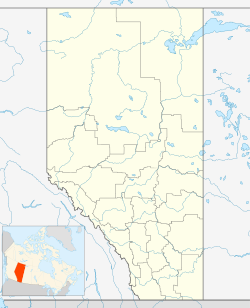Frank, Alberta
| Frank | |
|---|---|
| Location of Frank in Alberta | |
| Coordinates: 49°36′10″N 114°24′28″W / 49.6028°N 114.4078°WCoordinates: 49°36′10″N 114°24′28″W / 49.6028°N 114.4078°W | |
| Country |
|
| Province |
|
| Census division | No. 15 |
| Specialized municipality | Municipality of Crowsnest Pass |
| Government | |
| • Type | Unincorporated |
| • Governing body | Municipality of Crowsnest Pass Council |
| Population (2011) | |
| • Total | 112 |
| Time zone | MST (UTC−7) |
| • Summer (DST) | MDT (UTC−6) |
Frank is an urban community in the Rocky Mountains within the Municipality of Crowsnest Pass in southwest Alberta, Canada. It was formerly incorporated as a village prior to 1979 when it amalgamated with four other municipalities to form Crowsnest Pass.
In 1901, American entrepreneurs Sam Gebo and Henry Frank developed the first of many coal mines in the Crowsnest Pass, in the base of Turtle Mountain. In May that year the first buildings were erected in the new community of Frank, located on flat land between the Canadian Pacific Railway tracks and the mine. The town’s grand opening on September 10, 1901 was an all-day event that included sporting competitions (with engraved medals for the victors), tours of the mine, a banquet, and a dance. Two special trains brought in the guests, and the gourmet food (including a ton of ice cream). Henry Frank presided over the event, which was attended by the premier Frederick W. A. G. Haultain, his public works minister and federal Minister of the Interior, Clifford Sifton. Frank became the first incorporated village in the Pass and by 1903 served 1000 people with two dozen businesses and services, a two-story brick school and a regional post office.
The Frank Slide of 1903 destroyed much of the mine’s infrastructure, several rural businesses, and seven houses on the outskirts of Frank, killing 70-90 people. However the mine reopened within weeks and the rail line was soon re-established through the slide path. Frank continued to boom, and in 1905-06 a new residential subdivision was developed out north of the tracks to keep pace with mine production, a new zinc smelter, and a new three-story hotel (Rocky Mountains Sanatorium) close to a cold sulphur spring. A small zoo was built near the hotel.
However a period of decline soon followed. Due to market forces the zinc smelter never operated, and was converted to an ice skating arena. Fears of a second slide led to a government-ordered closure of the south townsite in 1911, and over the next several years its buildings were torn down or moved. The 1905 subdivision remained, but Frank ceased to be an important centre after the mine closed temporarily in 1912 and permanently in 1917. The Sanatorium, converted to a military hospital in 1917, was torn down in 1928 after a period of abandonment. The post office was finally closed in 1968
...
Wikipedia

